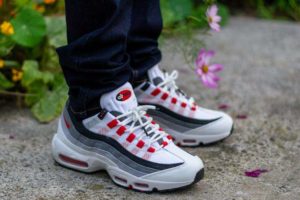Nike shoes fit in a variety of ways depending on the materials and model. Still, some generalizations can be made to make your life easier when buying some Nikes.
Nike Shoes Run Small
Overall, Nike has a reputation for running small. While the length is generally normal, the smaller fit comes from pairs with stiffer padding or a narrower width.

On a proper fitting shoe, there should be a little room around the pinky toe and in front of the big toe, without significant heel slippage. On many Nikes, particularly those with stiffer uppers, the fit at true to size will seem snug widthwise. Nikes are particularly narrow in the toebox area.
Personally, I tend to get pinky rub on certain pairs such as modern Nike SB Dunks if I go true to size. These Nike shoes fit in a way that makes them feel narrow. This of course will break in with wear. Going up a half size in pairs like that often results in a proper feeling width and a bit of extra length and heel slippage.
Nike Shoes Are True To Size
Nike shoes fit slightly narrow at true to size, generally speaking. Different pairs will have different fits, with some being more accurate than others.

Some Nikes, particularly those with mesh uppers or softer materials, will fit fine at true to size. Others, usually those with stiffer materials and/or padding will feel about a half size too small.
Performance sneakers from Nike such as basketball shoes will have a tighter fit. This is necessary for reducing injury while playing. For pairs like these, true to size can work for playing a game, but for casual wear a half size up can be helpful for comfort.
Other sneakers from the brand that are comprised of flyknit or soft suedes, meshes and leathers will be way more forgiving. These sneakers can often be purchased at true to size or even a half size down occasionally with little to no break in time. Some of these more generous fits include Dunks (non-SB) and Air Force 1s.
If your sneakers feel slightly too narrow, your options are to either increase by a half size (very typical for Nikes), or break them in. Breaking them in can hurt at first as the sneaker softens up and adapts to your foot shape. A shoe stretcher when used properly can help accelerate this process.
Nike Shoes Loosen Up
With the exception of stiffer, performance-based sneakers, most Nike shoes fit will loosen up as they break in.

If a shoe is comprised of typical casual materials such as suede, mesh or leather, over time even the tightest pairs should loosen up. Simply wearing the sneakers softens them up.
Pairs that fit snug at true to size like the Air Max 95 often will break in after a wear or two. Other pairs, such as the Lebron 18, are less forgiving as they are built to hold their shape while playing basketball.
Generally, any shoe will eventually break in and loosen up. As the materials interact with the heat from your feet, they soften and adapt to your foot shape. Very stiff pairs may take several wears (or several games, depending on their use) before they fully conform to the wearer’s feet.
Nike Shoes Can Stretch
Some Nikes can stretch. Many pairs are constructed with mesh uppers made out of materials such as flyknit, which instantly conforms to the wearer’s foot.

Casual sneakers like the Space Hippie line are built more like a “sock-shoe”. This design is created for an optimal fit with no break in time. These types of Nike shoes seem like they fit snug but stretch to your feet. When you take them off, they tighten back up and revert to the shape they were in before you put them on.
Other pairs made of more traditional materials will stretch a tad as far as breaking in, but do not have the same elasticity that the mesh pairs described above do. For example, a premium pair of Air Force 1 Crafts made from soft leather will break in and stretch to your foot shape slightly, but will remain in that shape after you take the shoes off, rather than tighten back up.
It is clear then that the type of stretch that will happen depends on the materials used on the upper. Stretchy materials means instant conformity to foot shape and an elastic return to stock shape when taken off. Non-stretchy materials mean a slower break in time and less elasticity when removed.
How Nike Shoes Fit Compared To Adidas
Generally speaking, Nike shoes fit smaller than adidas. This varies by model and material however.

Overall, most adidas I have owned have provided a roomier fit at true to size than most Nikes, right out of the box. This is true as far as casual sneakers like the adidas Forum as well as “stretchy” sneakers such as the Ultraboost.
While I have often gone up a half size on certain stiffer Nikes, I have consistently been able to use true to size for adidas. Some Nike shoes fit closer to a pair of adidas with a more generous fit. Generally speaking though, Nike tends to have more and stiffer padding in their modern sneakers. This results in a narrower fit than many adidas releases.
With some adidas, I’m able to wear a half size smaller than normal, which is way more rare for a pair of Nikes. Air Force 1s and non-SB dunks, as mentioned above, can constitute exceptions to this depending on materials used.
Find Your Nike Size
Rather than guess what size you wear in Nikes, you can use my sneaker size converter tool here!
